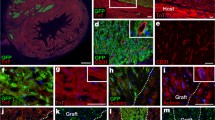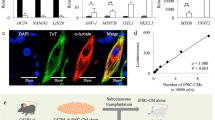Abstract
Accumulating evidence suggests that transplantation of human pluripotent stem cell-derived cardiomyocytes (hPSC-CMs) can regenerate the injured heart, which has triggered a wave of clinical trials. Since most preclinical studies were performed in xenogeneic transplantation models, little is known on post-transplant immunity in allogeneic models, as is the case in clinics. The current immunosuppressant protocols following hPSC-CM transplantation in clinical trials are equivalent to those following heart transplantation; however, the optimal protocol for cell transplantation may differ. In this chapter, I will describe the recent efforts to optimize immunosuppressant protocols via allogeneic transplantation models in non-human primates as well as novel approaches to reduce the amount of immunosuppressants.
Access this chapter
Tax calculation will be finalised at checkout
Purchases are for personal use only
Similar content being viewed by others
References
Thomson, J.A., Itskovitz-Eldor, J., Shapiro, S.S., Waknitz, M.A., Swiergiel, J.J., Marshall, V.S., et al.: Embryonic stem cell lines derived from human blastocysts. Science. 282(5391), 1145–1147 (1998)
Takahashi, K., Tanabe, K., Ohnuki, M., Narita, M., Ichisaka, T., Tomoda, K., et al.: Induction of pluripotent stem cells from adult human fibroblasts by defined factors. Cell. 131(5), 861–872 (2007)
Minami, I., Yamada, K., Otsuji, T.G., Yamamoto, T., Shen, Y., Otsuka, S., et al.: A small molecule that promotes cardiac differentiation of human pluripotent stem cells under defined, cytokine- and xeno-free conditions. Cell Rep. 2(5), 1448–1460 (2012). https://doi.org/10.1016/j.celrep.2012.09.015
van Laake, L.W., Passier, R., Doevendans, P.A., Mummery, C.L.: Human embryonic stem cell-derived cardiomyocytes and cardiac repair in rodents. Circ. Res. 102(9), 1008–1010 (2008). https://doi.org/10.1161/circresaha.108.175505
Laflamme, M.A., Chen, K.Y., Naumova, A.V., Muskheli, V., Fugate, J.A., Dupras, S.K., et al.: Cardiomyocytes derived from human embryonic stem cells in pro-survival factors enhance function of infarcted rat hearts. Nat. Biotechnol. 25(9), 1015–1024 (2007)
Shiba, Y., Fernandes, S., Zhu, W.Z., Filice, D., Muskheli, V., Kim, J., et al.: Human ES-cell-derived cardiomyocytes electrically couple and suppress arrhythmias in injured hearts. Nature. 489(7415), 322–325 (2012). https://doi.org/10.1038/nature11317
Chong, J.J., Yang, X., Don, C.W., Minami, E., Liu, Y.W., Weyers, J.J., et al.: Human embryonic-stem-cell-derived cardiomyocytes regenerate non-human primate hearts. Nature. 510(7504), 273–277 (2014). https://doi.org/10.1038/nature13233
Shiba, Y., Filice, D., Fernandes, S., Minami, E., Dupras, S.K., Biber, B.V., et al.: Electrical integration of human embryonic stem cell-derived cardiomyocytes in a Guinea pig chronic infarct model. J. Cardiovasc. Pharmacol. Ther. 19(4), 368–381 (2014). https://doi.org/10.1177/1074248413520344
Liu, Y.W., Chen, B., Yang, X., Fugate, J.A., Kalucki, F.A., Futakuchi-Tsuchida, A., et al.: Human embryonic stem cell-derived cardiomyocytes restore function in infarcted hearts of non-human primates. Nat. Biotechnol. 36(7), 597–605 (2018). https://doi.org/10.1038/nbt.4162
Okahara-Narita, J., Umeda, R., Nakamura, S., Mori, T., Noce, T., Torii, R.: Induction of pluripotent stem cells from fetal and adult cynomolgus monkey fibroblasts using four human transcription factors. Primates. 53(2), 205–213 (2012). https://doi.org/10.1007/s10329-011-0283-1
Suemori, H., Tada, T., Torii, R., Hosoi, Y., Kobayashi, K., Imahie, H., et al.: Establishment of embryonic stem cell lines from cynomolgus monkey blastocysts produced by IVF or ICSI. Dev. Dyn. 222(2), 273–279 (2001). https://doi.org/10.1002/dvdy.1191
Ishigaki, H., Shiina, T., Ogasawara, K.: MHC-identical and transgenic cynomolgus macaques for preclinical studies. Inflamm. Regen. 38, 30 (2018). https://doi.org/10.1186/s41232-018-0088-3
Barnard, C.N.: The operation. A human cardiac transplant: an interim report of a successful operation performed at Groote Schuur Hospital, Cape Town. S. Afr. Med. J. 41(48), 1271–1274 (1967)
Chang, D.H., Youn, J.-C., Dilibero, D., Patel, J.K., Kobashigawa, J.A.: Heart transplant immunosuppression strategies at cedars-Sinai medical center. Int. J. Heart Fail. 3(1), 15–30 (2021)
Eisen, H.J., Kobashigawa, J., Keogh, A., Bourge, R., Renlund, D., Mentzer, R., et al.: Three-year results of a randomized, double-blind, controlled trial of mycophenolate mofetil versus azathioprine in cardiac transplant recipients. J. Heart Lung Transplant. 24(5), 517–525 (2005). https://doi.org/10.1016/j.healun.2005.02.002
Kahan, B.D.: Cyclosporine. N. Engl. J. Med. 321(25), 1725–1738 (1989). https://doi.org/10.1056/nejm198912213212507
A comparison of tacrolimus (FK 506) and cyclosporine for immunosuppression in liver transplantation. N. Engl. J. Med. 331(17), 1110–1115 (1994). https://doi.org/10.1056/nejm199410273311702
Penninga, L., Møller, C.H., Gustafsson, F., Steinbrüchel, D.A., Gluud, C.: Tacrolimus versus cyclosporine as primary immunosuppression after heart transplantation: systematic review with meta-analyses and trial sequential analyses of randomised trials. Eur. J. Clin. Pharmacol. 66(12), 1177–1187 (2010). https://doi.org/10.1007/s00228-010-0902-6
Lindenfeld, J., Miller, G.G., Shakar, S.F., Zolty, R., Lowes, B.D., Wolfel, E.E., et al.: Drug therapy in the heart transplant recipient: part II: immunosuppressive drugs. Circulation. 110(25), 3858–3865 (2004). https://doi.org/10.1161/01.cir.0000150332.42276.69
Menasché, P., Vanneaux, V., Hagège, A., Bel, A., Cholley, B., Parouchev, A., et al.: Transplantation of human embryonic stem cell-derived cardiovascular progenitors for severe ischemic left ventricular dysfunction. J. Am. Coll. Cardiol. 71(4), 429–438 (2018). https://doi.org/10.1016/j.jacc.2017.11.047
Cyranoski, D.: ‘Reprogrammed’ stem cells approved to mend human hearts for the first time. Nature. 557(7707), 619–620 (2018). https://doi.org/10.1038/d41586-018-05278-8
Yamada, N., Okano, T., Sakai, H., Karikusa, F., Sawasaki, Y., Sakurai, Y.: Thermo-responsive polymeric surfaces; control of attachment and detachment of cultured cells. Die Makromolekulare Chemie Rapid Commun. 11(11), 571–576 (1990). https://doi.org/10.1002/marc.1990.030111109
Romagnuolo, R., Masoudpour, H., Porta-Sánchez, A., Qiang, B., Barry, J., Laskary, A., et al.: Human embryonic stem cell-derived cardiomyocytes regenerate the infarcted pig heart but induce ventricular Tachyarrhythmias. Stem Cell Rep. 12(5), 967–981 (2019). https://doi.org/10.1016/j.stemcr.2019.04.005
Ogasawara, T., Okano, S., Ichimura, H., Kadota, S., Tanaka, Y., Minami, I., et al.: Impact of extracellular matrix on engraftment and maturation of pluripotent stem cell-derived cardiomyocytes in a rat myocardial infarct model. Sci. Rep. 7(1), 8630 (2017). https://doi.org/10.1038/s41598-017-09217-x
Wunderlich, S., Haase, A., Merkert, S., Beier, J., Schwanke, K., Schambach, A., et al.: Induction of pluripotent stem cells from a cynomolgus monkey using a polycistronic simian immunodeficiency virus-based vector, differentiation toward functional cardiomyocytes, and generation of stably expressing reporter lines. Cell. Reprogram. 14(6), 471–484 (2012). https://doi.org/10.1089/cell.2012.0041
Saito, Y., Naruse, T.K., Akari, H., Matano, T., Kimura, A.: Diversity of MHC class I haplotypes in cynomolgus macaques. Immunogenetics. 64(2), 131–141 (2012). https://doi.org/10.1007/s00251-011-0568-y
Ling, F., Wei, L.Q., Wang, T., Wang, H.B., Zhuo, M., Du, H.L., et al.: Characterization of the major histocompatibility complex class II DOB, DPB1, and DQB1 alleles in cynomolgus macaques of Vietnamese origin. Immunogenetics. 63(3), 155–166 (2011). https://doi.org/10.1007/s00251-010-0498-0
Shiba, Y., Gomibuchi, T., Seto, T., Wada, Y., Ichimura, H., Tanaka, Y., et al.: Allogeneic transplantation of iPS cell-derived cardiomyocytes regenerates primate hearts. Nature. 538(7625), 388–391 (2016). https://doi.org/10.1038/nature19815
Fernandes, S., Naumova, A.V., Zhu, W.Z., Laflamme, M.A., Gold, J., Murry, C.E.: Human embryonic stem cell-derived cardiomyocytes engraft but do not alter cardiac remodeling after chronic infarction in rats. J. Mol. Cell. Cardiol. 49(6), 941–949 (2010). https://doi.org/10.1016/j.yjmcc.2010.09.008
Gornalusse, G.G., Hirata, R.K., Funk, S.E., Riolobos, L., Lopes, V.S., Manske, G., et al.: HLA-E-expressing pluripotent stem cells escape allogeneic responses and lysis by NK cells. Nat. Biotechnol. 35(8), 765–772 (2017). https://doi.org/10.1038/nbt.3860
Xu, H., Wang, B., Ono, M., Kagita, A., Fujii, K., Sasakawa, N., et al.: Targeted disruption of HLA genes via CRISPR-Cas9 generates iPSCs with enhanced immune compatibility. Cell Stem Cell. 24(4), 566–78.e7 (2019). https://doi.org/10.1016/j.stem.2019.02.005
Jaiswal, S., Jamieson, C.H., Pang, W.W., Park, C.Y., Chao, M.P., Majeti, R., et al.: CD47 is upregulated on circulating hematopoietic stem cells and leukemia cells to avoid phagocytosis. Cell. 138(2), 271–285 (2009). https://doi.org/10.1016/j.cell.2009.05.046
Deuse, T., Hu, X., Gravina, A., Wang, D., Tediashvili, G., De, C., et al.: Hypoimmunogenic derivatives of induced pluripotent stem cells evade immune rejection in fully immunocompetent allogeneic recipients. Nat. Biotechnol. 37(3), 252–258 (2019). https://doi.org/10.1038/s41587-019-0016-3
Nafady-Hego, H., Li, Y., Ohe, H., Zhao, X., Satoda, N., Sakaguchi, S., et al.: The generation of donor-specific CD4+CD25++CD45RA+ naive regulatory T cells in operationally tolerant patients after pediatric living-donor liver transplantation. Transplantation. 90(12), 1547–1555 (2010). https://doi.org/10.1097/TP.0b013e3181f9960d
Otsuka, R., Wada, H., Tsuji, H., Sasaki, A., Murata, T., Itoh, M., et al.: Efficient generation of thymic epithelium from induced pluripotent stem cells that prolongs allograft survival. Sci. Rep. 10(1), 224 (2020). https://doi.org/10.1038/s41598-019-57088-1
Yoshida, S., Miyagawa, S., Toyofuku, T., Fukushima, S., Kawamura, T., Kawamura, A., et al.: Syngeneic mesenchymal stem cells reduce immune rejection after induced pluripotent stem cell-derived allogeneic cardiomyocyte transplantation. Sci. Rep. 10(1), 4593 (2020). https://doi.org/10.1038/s41598-020-58126-z
Author information
Authors and Affiliations
Corresponding author
Editor information
Editors and Affiliations
Rights and permissions
Copyright information
© 2022 The Author(s), under exclusive license to Springer Nature Switzerland AG
About this chapter
Cite this chapter
Shiba, Y. (2022). Allogeneic Immunity Following Transplantation of Pluripotent Stem Cell-Derived Cardiomyocytes. In: Zhang, J., Serpooshan, V. (eds) Advanced Technologies in Cardiovascular Bioengineering. Springer, Cham. https://doi.org/10.1007/978-3-030-86140-7_5
Download citation
DOI: https://doi.org/10.1007/978-3-030-86140-7_5
Published:
Publisher Name: Springer, Cham
Print ISBN: 978-3-030-86139-1
Online ISBN: 978-3-030-86140-7
eBook Packages: EngineeringEngineering (R0)




